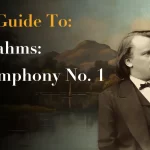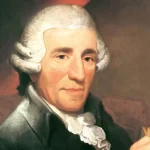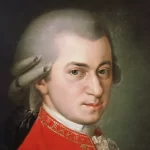Johannes Brahms (1833-1897) was one of the leading figures of the late romantic era of classical music. Born into a musical family in Hamburg, he enjoyed a diverse musical education, with thorough training in piano as well as violin and cello. Later on, he also took positions as a conductor and made his first composition attempt at an early age.
Brahms was lucky enough to be acquainted with leading musical figures of the time, most notably the great violinist Joseph Joachim and the Schumann couple, who were both instantly enthralled by the young composer’s abilities and encouraged him musically as well as financially, arranging concerts and posting glowing reviews of his music. With the early demise of Robert Schumann, Brahms continued to be the center of this music group, performing and collaborating with Joachim, Clara and others.
After many attempts at composing small and large scaled works, it was the German Requiem (1866) that gave him the breakthrough as a composer, enthusiastically received and performed in many German cities. Later on, and after many struggles, his First Symphony (1876) marked another highlight, after which Brahms enjoyed a successful and well-respected career until his death at the age of 64.
During his later years, Brahms was considered an authentic successor to the great classical tradition of western music, continuing the aesthetic of Bach, Haydn and, most importantly, Beethoven. That also made him a target to the arrows of representatives of the “new music” such as Richard Wagner. Indeed, Brahms music combines the order and thematic treatment of musical ideas of the old masters of classical music (he was also busy editing and publishing works by past composers such as Couperin, Schubert, Handel and Mozart), yet he also incorporates a warm, long musical phrases with often thick orchestral, chamber and instrumental sound that stand in accordance with the style of the late 19th century music.
Here are 10 pieces by Brahms we recommend as a beginning point for anyone who wishes to get acquainted with the music of this great composer. We also recommended recordings for each piece which, though not necessarily the “best available”, also represent a good starting point to the music. Don’t forget to subscribe to our classical music newsletter and be notified for more guides, new classical music album reviews and news.
Hungarian Dances
Brahms originally wrote the Hungarian Dances for piano duo, played 4 hands, mainly for amateur pianists. Their popularity proved so great, it continued to give Brahms a respected income throughout his life. Later on, the composer transcribed the dances to piano 2 hands, and orchestrated 3 of the dances. The orchestra cycle we know today was transcribed, beside the 3 Brahms transcriptions, by composers such as Dvorak, Parlow, gál and Schmerling, who gave us the most famous transcription of all – that of Hungarian Dance No. 5. It is one of these rare classical music pieces people can whistle or use as a ringtone without ever knowing where it originated from.
Claudio Abbado was a masterful Brahms interpreter, but the Vienna Philharmonic is the real star of this Deutsche Grammophon release, containing the 21 dances in their orchestra form. The Viennese play with charm and warmth few if any other ensemble can match.
Symphony No. 1, Op. 68
It took Brahms more than 20 years to build the courage of composing and publishing his first Symphony. This may explain why, contrary to other composers’ early efforts in the symphonic field, this symphony sounds completely mature, planned and executed to the last detail. The piece includes one of the more exciting introductions of any symphony, with a long, dramatic “organ point” (a single bass stretched over few bars and harmonic changes), the two outer movements are irresistibly enthralling. But there is tenderness too, with the two middle movements serve as a delightful contrast to the finale, which includes one of Brahms’ more enticing melodies, often compared to Beethoven’s Ninth Symphony’s finale theme. Very soon after its premiere, this symphony rightly earned its place in the standard symphonic repertoire, and it remains in it till this day, along with the composers’ other three symphonies.
Because of this symphony’s prominence, there is hardly any orchestra or conductor who didn’t perform and record it. Otto Klemperer’s recording from the early 1960s has never been surpassed, projecting immense force, inner drive and concentration. The recording quality is surprisingly good, remains atmospheric yet transparent to the nuances of the Philharmonia Orchestra.
Symphony No. 4, Op. 98
The last of Brahms’ Symphonies, it earned its place among Brahms’ greatest achievements in any musical form. Compared to the First Symphony, the Fourth sounds a bit more modest, mellow and tightly organized, its emotional range coming from within rather than outwardly projected. Brahms reached his absolute best in combining classical tradition with romanticism and progressive compositional methods; This is a classically built, 4 movements Symphony, with the first movement in a sonata form, the second slow Andante, a brilliant, Scherzo-like “Allegro Giocoso” and a final “Passacaglia”, a form of variations on simple musical elements. Nonetheless, Brahms builds intricate relationships and eludes to pieces by himself and other composers, as well as, ever so slightly, breaking from the traditional architectural structure of the classic forms. With all of its musicological sophistication, it’s still a deeply moving and humane work, that will give any Brahms or classical music enthusiast a lifetime of enjoyment.
When Carlos Kleiber joins forces with the Vienna Philharmonic, magic happens, and their performance of the Fourth Symphony is no exception. The recording, from the early digital age (1981) sounds much better in recent masterings and should be in any Brahms collection.
Haydn Variations, Op. 56
Another famous symphonic piece originally written for the keyboard, this time originally for two pianos. Contrary to the majority of the Hungarian Dances, this is an orchestral transcription by the composer himself, and already showing him as a master of the craft. In fact, it’s one of the better-orchestrated pieces by the composer. The piece is a classic-form variations based on a simple theme by what Brahms originally thought to be by Joseph Haydn. Later research disputed the Haydn attribution but nonetheless, Brahms makes the most of the naïve theme, bringing the piece to a close with a direct quote that uses the entire orchestra, to a moving effect.
Wilhelm Furtwängler and the Vienna Philharmonic lived and breathed Brahms’ music, and there is hardly a better example of their affinity to this composer than their recording of the Haydn Variations from their early 1950’s. This performance never left the catalog and is included in many versions and collections of the Vienna Philharmonic or Furtwängler (see below). If you are bothered by the mono recording and want a digital version, Marin Alsop gives a highly engaging performance with the London Philharmonic Orchestra, along with a persuasive account of the Third Symphony.
Violin Concerto, Op. 77
Violinist Joseph Joachim, Brahms’ dear and lifelong friend, said of this Violin Concerto that it’s “one of the big four German Violin Concertos” (referring to the Violin Concertos by Beethoven, Brahms, Mendelssohn and Bruch). This is a symphonic-scaled work, where the violinist, besides his considerable technical challenges, needs to overcome a large orchestra as well as function as a chamber partner to individual players from the orchestra.
Itzhak Perlman, accompanied by the Chicago Symphony Orchestra under Carlo Maria Giulini, gives one of the best performances of this concerto on record, with a combination of human warmth, technical command and in-depth understanding of the structure of this work. The slow movement is particularly lovely, and the recording from 1977 has been very well remastered.
Piano Concerto No. 1. Op. 15
Like many of Brahms’ early works from his twenties, this work took many years to be completed, and even more to be excepted as a true masterpiece. Started off as a sonata for 2 pianos, then a symphony, it became a three movements piano concerto at the late 1850s. The work incorporated advice and guidance of many of the composer’s close friends, such as Clara Schumann and Joseph Joachim, as well as Julius Otto Grimm, who greatly helped the inexperienced Brahms with the orchestration of the piece. The first several performances, with either Brahms or Clara Schumann as soloists, generally were not received warmly. It took few decades for the piece to be fully appreciated, based on further successes by the composer, as well as the success of his second, more somber and mature piano concerto.
Hearing the concerto in historical perspective, it’s not hard to understand the difficulty the contemporary audience of the mid 19th century had with this piece. Unlike virtuosic piano concertos of the day, this piece’s piano role, although tremendously difficult, is not immediately apparent to the average listener and serves the music more than the technical abilities of the soloist. The first and final movement is in symphonic proportions, with the piano taking sometimes an accompanying role. The slow movement, one of Brahms’ more inspiring creations, is long, stilled and atmospheric. The finale is an energetic Rondo, which includes dancing elements and finishing off with a more optimistic mood.
There are several legendary performances of Brahms’ two extremely difficult piano concertos, from the early Backhaus recordings, through Gillels, Fleisher, Serkin and many more. The digital age saw fantastic performances by Kovacevich, Brendel and Ax. But you can never go wrong with this superb live recording of the 2 Concertos by Nelson Freire, with the Gewandhausorchester (who gave several Brahms premiere performances) under Riccardo Chailly. The First Piano Concerto receives one of its best performances on record, and the second concerto included in the album is no less successful. Great life-like recording quality as well.
Double Concerto. Op. 102
This unusual concerto for violin, cello and orchestra is looking to the past and the “Concerto Grosso” technique, yet also incorporates a completely new style of writing for the instruments. The cello role was considered awkwardly written by cellists but is today accepted by all of the greatest soloists. The piece was written for two of Brahms’ closest friends and colleagues, violinist Joseph Joachim, who also championed the Violin Concerto but was estranged from Brahms due to a personal reef for years prior of performing this concerto, and cellist Robert Hausmann, member of the renowned “Joachim Quartet”. The orchestral part is pure Brahms, in the level of his symphonies and other solo concertos, and it remains one of Brahms’ most beloved works.
Since recording this concerto with the A-team of the Cleveland Orchestra under the superb Brahms interpreter George Szell, David Oistrakh and Mstislav Rostropovich’s performance of the Double Concerto has rarely been surpassed on record. Everything seems to sound just right, with a glowing performance by soloists and orchestra alike, and a recording that sounds remarkably well despite its age. Another must-have on any Brahms collection.
Piano Quintet, Op. 34
Brahms’ two Quintets, one for piano and strings and the other for clarinet and strings (see below), are his best accomplishments from his distinguished chamber music output. The Piano Quintet, unlike that of Schumann’s for the same ensemble, gives more equality for all participants, making it less of a pianistic piece with strings accompaniment and more of a true chamber work. The piece is well diverse, with dramatic, serene, humorous and dance-like episodes combined together for an exhilarating piece, from start to finish.
For a truly exceptional recording that captures the essence of this collaborative work, look no further than the performance by Maurizio Pollini on piano with the Quartetto Italiano, released on Deutsche Grammophon with a clear yet warm analogue recording. This collaboration between musical giants results in a powerful and nuanced interpretation that brings Brahms’ masterpiece to life.
Clarinet Quintet, Op. 115
Brahms was contemplating retirement after completing and successfully premiering his second String Quintet (Op. 111), yet his encounter with the clarinetist Richard Mühlfeld made him break with his decision and compose 2 Sonatas for Clarinet and Piano, Clarinet Trio and the Clarinet Quintet, one of his absolute best works from his last decade as a composer. Heavily influenced by Mozart’s own clarinet quintet, Brahms composed a piece of quiet depth and deep coloristic effects of the ensemble. The finale, like in Mozart’s piece, is a set of variations on an original theme.
The Tokyo Quartet is joined by Clarinetist Richard Stoltzman to give a clean, uniformed account which is impressive by its modesty and superb control.
Late Piano Music. Op. 117-119
Although dedicating himself to composition and musicological research from an early age, Brahms was also a distinguished pianist, writing for the instrument some large scale works as the third piano sonata (Op. 5) or the 4 ballads Op. 10, continuing to compose for the instrument as a chamber participant or concerto soloist. But it seems that he reached the absolute purification of his piano writing in late age, with the short pieces that comprise Op. 117-119. These concise, often quiet works demand a considerable concentration and control to project well, and though not the most technically demanding works of the period, they were almost immediately thought of as canonical piano music. Some include a previously composed group of “Fantasies” Op. 116 in this group of late piano works, but the opuses 117-119 are on a league of their own.
Radu Lupu gives a masterful account of the late piano pieces, with a performance that many pianists have tried yet didn’t manage to surpass. Lupu’s pianism is transparent, intimate, and reminding the listener that these pieces were mainly written for private consumption and not for a public, showy display. The recording is close and a bit dry, but that does not prevents from enjoying this one of a kind recording.
Top image: ©️ The Classic Review (AI generated).

This concludes our beginners guide to Brahms. Visit our Beginners Guides to classical music page and get to know more classical music composers. Sign up to our newsletter to get updated on new guides when they are published.





















